By Jeff Garrett for CoinWeek …..
When asked to write an article about 10 coins I would love to own, my thoughts immediately turned to my popular book 100 Greatest U.S. Coins. Most of the coins in that book have great stories, and that is what draws me to coins I would love to own. The subject of great coins is quite newsworthy at the moment, with trophy coins bringing record prices at auction. The recent sale of the NGC MS65 Brasher Doubloon for over $9 million stunned many observers. Despite the global pandemic, the wealth of many in this country has vastly increased over the last 12 months. Over 50 new billionaires were created in the last year. If I somehow became one of those newly minted billionaires, then the 10 coins below would top my shopping list.
MCMMVII (1907) Indian Head Double Eagle Pattern
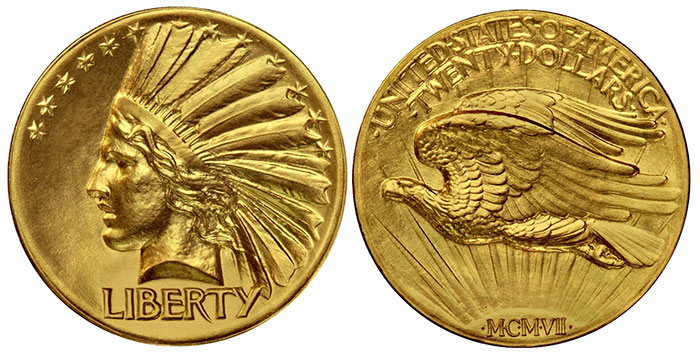
This is my absolute favorite coin and one that nearly every collector or dealer would covet above all others. This coin deserves a complete description and the following is from the fifth edition of my 100 Greatest U.S. Coins book:
The 1907 Indian Head double eagle is a pattern or experimental issue. It is one of America’s most stunning and desirable coins. President Theodore Roosevelt was personally involved in creating this fascinating issue. Roosevelt believed that the nation’s coinage was unattractive and without artistic merit. Years earlier, while vice president, Roosevelt had become acquainted with the famous sculptor Augustus Saint-Gaudens, whose works include Diana, sculpted in 1892 for the original Madison Square Garden; the Sherman Victory monument in New York City; Hiawatha for Saratoga, New York; and many others. It is not certain when Roosevelt first decided to commission Saint-Gaudens to create a new coinage, but by December 27, 1904, he wrote to Secretary of the Treasury Leslie Mortier Shaw: “I think our coinage is artistically of atrocious hideousness. Would it be possible, without asking permission of Congress, to employ a man like Saint-Gaudens to give us a coinage that would have some beauty?”
The president was enamored with the beauty and high relief of ancient Greek coinage. At one time, Roosevelt wanted to change the designs of the entire U.S. coinage. Because of the difficulty of adapting modern minting techniques to the high-relief effects that Roosevelt desired, Saint-Gaudens concentrated his efforts on the eagle and double eagle issues.
By means of extensive personal correspondence with the artist at his studio in Cornish, New Hampshire, Roosevelt contributed greatly to the design of this and several issues of the period. He wanted to include the use of an American Indian in full headdress. Saint-Gaudens wrote to Roosevelt in 1907: “I like so much the head with the head-dress, and by the way, I am very glad you suggested doing the head in that manner.” Although Saint-Gaudens preferred the Indian design for the double eagle, the standing Liberty (now known as “Saint-Gaudens”) theme was chosen for that denomination. The Indian Head design is similar to the design adopted for the regular-issue eagle. In his last letter to the president, Saint-Gaudens wrote: “The majority of the people that I show the work to evidently prefer with you the figure of Liberty to the head of Liberty and that I shall not consider any further on the twenty-dollar gold coin.” At the request of the artist, however, one example was struck for comparison.
The pedigree of this extraordinary coin began with Charles Barber, the chief engraver of the U.S. Mint. Waldo Newcomer purchased the coin directly from his estate. The coin was then sold to the prominent collector F.C.C. Boyd. Boyd’s wife sold the coin for a reported $1,500 to Abe Kosoff and Abner Kreisberg around 1945. The coin was then sold to King Farouk of Egypt for slightly less than $10,000. After King Farouk was overthrown, his collection of rare coins was auctioned in 1954. The coin sold for approximately $3,444, again to Abe Kosoff, who placed the coin with Roy E. (“Ted”) Naftzger Jr. In 1956 Dr. J.E. Wilkison obtained the coin for $10,000. It was sold in 1973 to Paramount International Coin Corporation as part of the Wilkison Gold Pattern Collection. The Wilkison Gold Pattern Collection was then traded to A-Mark Financial. It was then sold by private treaty to Maryland dealer Julian Leidman in 1979 for $500,000. Jack Hancock and Bob Harwell purchased the coin in the 1981 American Numismatic Association auction sale for $475,000. Several years later, it was sold to a major Northeastern collector of Saint-Gaudens coinage and is today the cornerstone of that collection. The coin has not been shown publicly for nearly four decades. This probably explains why the coin is not ranked higher on the list of 100 Greatest U.S. Coins. It is author Jeff Garrett’s personal favorite coin, and would rank No. 1 if he was the only one voting.
MCMMVII (1907) Ultra High Relief Double Eagle
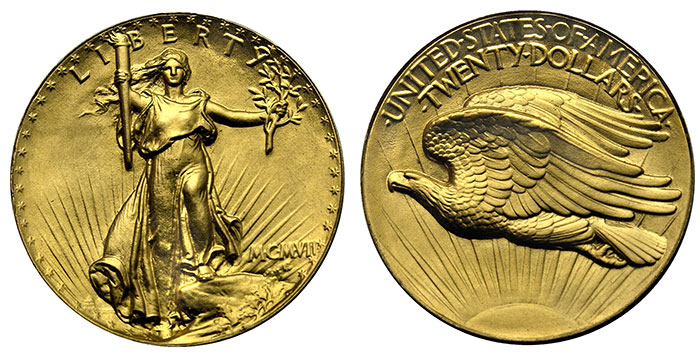
In my opinion, no other coin matches the artistic appeal of the 1907 Ultra High Relief double eagle. The coin is so sculptural, and the relief so high, that even with modern equipment the coin is difficult to fully capture in a photograph. If given the opportunity, you should make an effort to view one of these amazing coins in person. It’s a shame these coins are so expensive and that only mega-wealthy collectors can own one.
President Theodore Roosevelt personally enlisted the great American sculptor, Augustus Saint-Gaudens, to redesign our coinage. Roosevelt was influenced by the artistic merits of ancient Greek coinage and wanted someone to fulfill his wishes. Saint-Gaudens was a natural choice, being the preeminent American artist of his time.
The 1907 Ultra High Relief is an experimental issue and was never practical for circulating coinage. Only about 18-20 examples are known, several of which are in museum collections. The Smithsonian collection contains three examples, one of which came from the widow of Augustus Saint-Gaudens. The last example (PR68) to appear at auction sold for $2.115 million in January 2015.
1861-D Gold Dollar
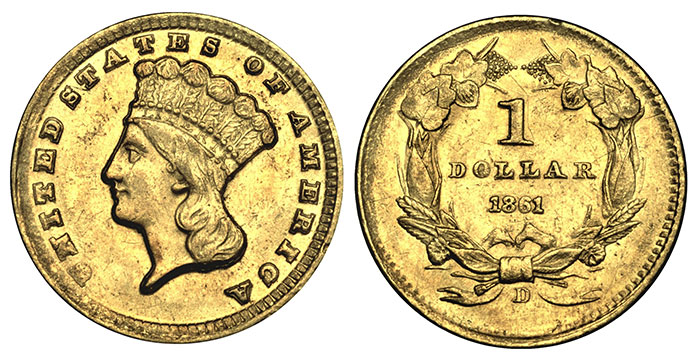
Historically speaking, the 1861-D gold dollar is one of the most interesting coins ever produced. The Dahlonega Mint was first established in 1838 to strike coins from the newly discovered gold found in the region and struck gold dollars, quarter eagles, three dollars, and half eagles until 1861. The Mint was seized by Confederate States of America troops in April of that year. About 500 to 1,000 1861-D gold dollars were then struck by the Confederates. Less than 100 examples have survived, and the issue is extremely popular with collectors.
Most are weakly struck in the UN of UNITED and many are with damage. A few amazing examples are known to have survived and were undoubtedly saved as souvenirs by members of the Confederacy when the Mint was occupied by the CSA.
The finest example known is an NGC MS65 that was part of the legendary Dukes Creek collection we sold around 2003. That coin last sold at auction for $149,500 in 2008.
1870-S Three Dollar Gold
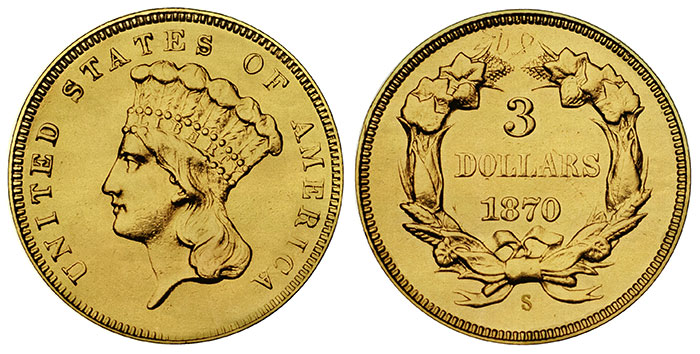
There is rare, and there is unique. Very few coins have a rarity comparable to the 1870-S Three Dollar gold coin. The only known example resides in the Harry Bass collection that is now on display in the Bass room of the American Numismatic Association (ANA) Money Museum in Colorado Springs, Colorado. Harry Bass purchased the coin in 1982 at the Eliasberg Sale for $687,500.
The 1870-S Three Dollar is unique but not aesthetically pleasing, having been repaired at some point in the past. The coin sold for $11,500 in 1911.
I have always like branch mint gold coins, and in my opinion, this would be the ultimate coin to own in the series. My guess is that the 1870-S Three Dollar will come to the market in the next several years. It will be fun to watch the billionaires compete for this mega rarity to complete their sets. The owner of this coin would be the only person able to own a complete set of United States coinage! In light of the market’s hypersensitivity to quality, it will be interesting to see if its state of preservation holds it back.
1856-O Proof Double Eagle
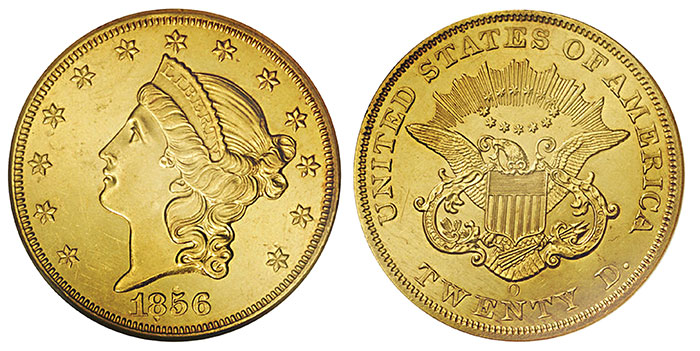
This coin makes my list because it is one of the ultimate “condition rarities” in all of United States numismatics. Collectors love Southern gold coins and the 1856-O double eagle is a prime rarity in any grade. Only 2,250 coins were struck and today less than 40 examples are known in all grades. The finest known example is fully prooflike, and considered by most experts to be a Proof or presentation piece. It is one of the most spectacular rarities in the U.S. gold series. The coin first sold at auction in 2002 for $310,500 and later for $1,437,500 in 2009. The coin increased in value by over $1,000,000 in less than seven years.
Any early Branch Mint Proof coin is an exciting numismatic rarity. A Proof example of a major rarity is another story altogether. I would love to own this coin. My guess is that it will set another major auction record when it again crosses the auction block.
1861 Paquet Double Eagle MS67

At one time the 1861 Paquet double eagle was considered a Pattern or Experimental coin. Modern research has proven the coin to be a regular issue coin struck for circulation. In 1860, Anthony Paquet, an engraver at the Philadelphia Mint, modified the reverse design for the double eagle. The new design was very similar to the standard issue, but the reverse letters were much taller and more slender in appearance. In late 1860, the Paquet Reverse became the standard design that was adopted for the regular-issue coinage of 1861 double eagles. Dies were shipped to the branch mints of New Orleans and San Francisco.
Actual coinage on high-speed presses began in January of 1861 in Philadelphia, but it was feared that the wider fields and narrow rim would cause breakage of the dies, so the use of planchet dies was discontinued. However, those dies that were used for coinage experienced no problems at all, proving their withdrawal was unnecessary. Regardless, Mint Director James Ross Snowden recalled the new design and ordered the melting of the 1861 double eagles made at the Philadelphia Mint. The entire Philadelphia run was destroyed, with the exception of a few coins.
Today only two examples are known, one of which is the spectacular MS67 that was once part of the Norweb collection. The coin is a miracle of preservation and one of the most desirable gold coins of the United States series.
1877 Pattern $50 Dollar Gold
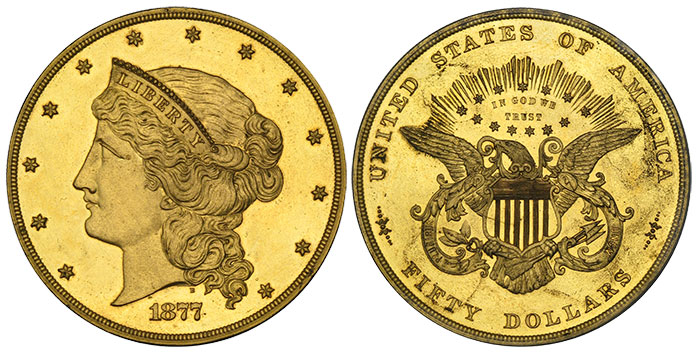
The two 1877 Pattern $50 gold coins that are now part of the Smithsonian collection are the most amazing coins in existence. The Half Unions, as they are known, are unique in the gold format and have a legendary past. The coins were struck as pattern coinage in 1877 to experiment with large denomination production. The original proposal for these coins came from California, which used only coins at the time because paper money was illegal under the state constitution. Gold $50 coins would have greatly facilitated banking.
The coins were thought to have been melted, but showed up in the estate of William Idler and were later sold to future Treasury Secretary William Woodin for the then-huge sum of $10,000 each. The sale caused enough controversy that Woodin felt pressured to trade the coins back to the U.S. Mint for what has been described as the “motherlode” of U.S. pattern coins. Many of the patterns extant today are thought to have originated with that trade.
If I could have my pick of the unfathomable collection at the Smithsonian, I would choose these two coins.
1822 Half Eagle
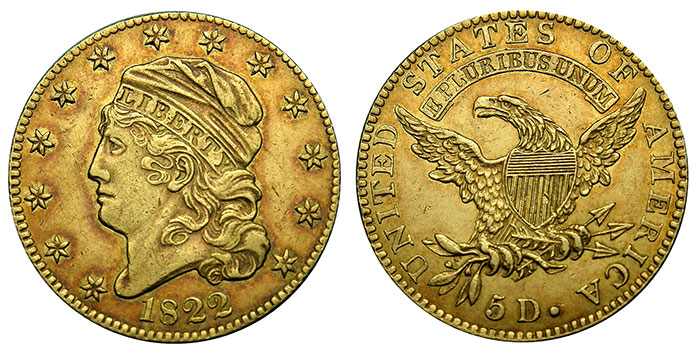
The 1822 half eagle is one of the rarest United States coins in existence. Only three examples are known, two of which are in the Smithsonian National Numismatic Collection. Only one coin remains in private hands. That coin has been retained by the Pogue family after selling one of the greatest collections ever assembled. It will probably come to market soon and when it does a new auction record for a United States coin could be established. Several billionaire collectors would love the bragging rights to this coin.
The 1822 half eagle is also one of the few coins in the top echelons of my 100 Greatest US Coins book that is an actual regular-issue coin. The coin has no nefarious or special circumstances for its rarity. There were simply only three survivors of its original 18,000 production.
1964 Peace Dollar

This coin is a timely addition to my list since the United States Mint plans to reissue an example of the Peace dollar in 2021. I have added this coin because of its legendary status and almost mythical history.
As many readers know, the Mint planned to strike Peace dollars in 1964 and began production at the Denver Mint in 1964. Before the coins could be released, however, it was decided to stop production and melt all that had been struck.
None were saved (that we know of), and it’s very surprising that an example was not retained by the Mint or sent to the Smithsonian collection.
Despite rumors that 1964 Peace dollars may exist, in my over 50 years of being involved in the hobby, I have never spoken to someone who had seen an example. There might be one somewhere, but if one exists, it has been one of the closest-held secrets in all of numismatics. Secrecy would be understandable, however, as it is nearly certain the Mint would confiscate any examples that surfaced. The coins were never officially released and are still considered property of the US government.
I would love to own briefly, even if my ownership would be fleeting.
Syracuse Decadrachm
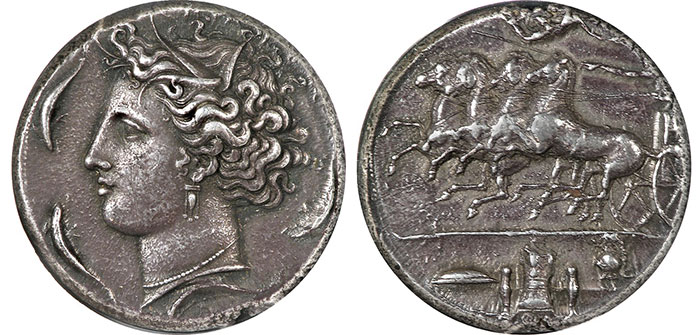
Ancient coins are not my area of expertise, but I have had the opportunity to handle several Syracuse decadrachms over the years. The coins were struck around 400 BCE and are in my opinion one of the most spectacular coins ever minted. It’s hard to believe that such an artistic masterpiece could be produced by hand almost 2,500 years ago. The coins are known to have been created by two of the greatest artists ancient world (among others), Kimon and Euainetos, each bringing their own distinctive style to this iconic issue.
Mint state examples of the Syracuse decadrachm do exist and trade hands occasionally. I have fond memories of my first ANA convention in 1974 where the legendary dealer Abe Kossof had a table. In one showcase Abe had a 1907 Ultra High Relief (my second pick) and in the other, he was displaying a mint condition Syracuse decadrachm. The show was in Miami and he was dressed in a crisp white summer suit. He made quite the impression on me. Maybe someday I can aspire to duplicate his exhibit, white summer suit and all.
* * *
About the Author
Growing up in the Tampa Bay area, Jeff Garrett began his coin collecting the all-American way, with Lincoln cents. He became very active in several local clubs and was mentored at an early age by many area dealers. Garrett attended his first American Numismatic Association (ANA) convention at the 1974 Miami convention and has not missed one since.
At the age of 17, he was offered a position with Florida Coin Exchange, one of the dominant firms of the day.
Several years later, Garrett had moved to Kentucky and organized the Bluegrass Coin Club in Lexington.
Over the course of his career as a coin dealer and a numismatist, he has handled nearly every United States rarity. During the ANA Convention in 2003, Garrett was one of the experts called upon to authenticate the long-lost 1913 Liberty nickel. Ten years later, Garrett and another partner purchased the coin at auction for over $3 million.
In 2009, he ran successfully for a seat on the Board of Governors for the ANA, and recently completed his term as president of the organization.
Although he spends most of his time buying and selling coins, Garrett enjoys research and the study of rare coins. Jeff has authored many of the most popular numismatic references published in the last decade. This includes the award-winning 100 Greatest U.S. Coins, now in its fifth edition, and the Encyclopedia of United States Gold Coinage. The encyclopedia was published in cooperation with the Smithsonian Institution.
Jeff is also an important part of the Smithsonian’s National Numismatic Department and serves as a consultant to the museum on funding, exhibits, conservation, and research. Thanks to Jeff’s and many others’ efforts, rare coins are once again on exhibit at the Smithsonian Museum of American History. Recently, Jeff was asked to serve as a board member of said museum.
Other numismatic works include the Redbook of Auction Records series, United States Coinage – A Study by Type, Gold – Everything You Need to Buy and Sell Today, 100 Greatest U.S. Modern Coins, and 1849: The Philadelphia Mint Strikes Gold. Jeff Garrett currently serves as senior editor for the Guide Book of United States Coins (the Redbook), the leading numismatic publication in the world. He finalizes the prices each year that are included in the Redbook.
Living in Lexington, Kentucky, he enjoys golf, travel and spending time with his family: his wife Mary Lynn, their daughter Morgan, and their son Benjamin, who also works in the numismatic business.






Jeff: The half unions were not in Idler’s collection. They were purchased by AL Snowden at face value and sold to Woodin via Haseltine & Nagy as were many other patterns.
Hola podrian mandarme informacion de subastas.
Saludos Eduardo
A 1907 UHR PR68 was sold last month by Heritage for $3.6 million.
If someone somehow got a 1964-D Peace dollar out of the Denver mint, and it was found out by the Secret Service today, all that person would need to do is donate it to the Smithsonian so that it could be saved and perhaps displayed for all to see rather than sent to Fort Knox to live with the 1933 St. Gaudens jailed there.
How much is an 1804 Silver Dollar?
A genuine one?